Abstract
A new graduate degree programme, Master of Science in Electric Vehicles (MScEV), for engineering students is presented, which is timely and vital for modern society. The purpose of this programme is to provide graduate students with up-to-date knowledge and skills that can enhance their career prospects in the fast-growing electric vehicle (EV) community. The programme not only provides technological knowledge in system design, operation, and management of EVs, but also involves research training in specific EV topics. This paper first outlines the rationale of the programme and reveals the shortcomings of existing EV education. Then, the curriculum structure of the newly developed MScEV programme as well as the corresponding core and elective courses are discussed. Finally, the findings of this programme are evaluated, indicating that the programme is attractive to an overwhelming number of students from diverse engineering backgrounds, as evidenced by the applicants’ and admittees’ degree qualifications and work experiences.
1. Introduction
Electric vehicles (EVs) are not new—the first EV was built in 1834, whereas the first internal combustion engine vehicle (ICEV) was developed in 1885—EVs are 51 years older than ICEVs. In the 1900s, EVs were the preferred road transportation, but their cost was prohibitive. Henry Ford ended the use of EVs when he produced the Model T with a much longer driving range than that of EVs but at only a fraction of their cost. By the 1930s, EVs almost vanished from the scene [].
The resurrection of EVs started at the outbreak of the energy crisis and oil shortage in the 1970s []. Unlike ICEVs, which rely heavily on oil- and gas-based fuels, EVs benefit from energy diversification by using electricity, which can be generated from a wide range of energy sources. Meanwhile, they can also offer the advantage of higher energy efficiencies. The well-to-wheels energy efficiency of battery EVs (BEVs) is higher than that of ICEVs by about 38% based on the same tank of crude oil [], as depicted in Figure 1. Additionally, with the inherent feature of regenerative braking, the energy efficiency of BEVs can be further improved by about 10%. Nevertheless, this impetus was insufficient to continuously fuel the development of EVs.
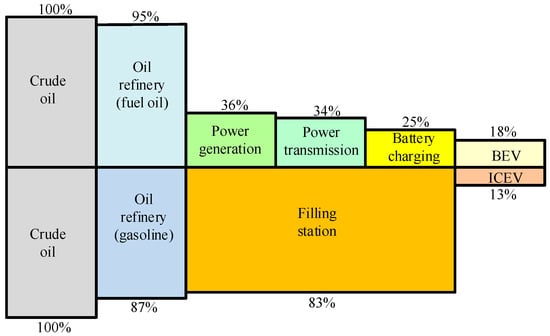
Figure 1.
Comparison of well-to-wheels energy efficiencies of BEVs and ICEVs.
The second impetus for the development of EVs was due to the growing concern over air quality and the greenhouse effect in the 1980s []. The use of EVs is the most viable solution to solve the ICEV pollution issue, as BEVs have much lower overall harmful emissions compared to ICEVs, even when accounting for gasoline production for ICEVs and electricity generation for BEVs [], as depicted in Figure 2. Also, the use of EVs can help reduce the carbon dioxide emission, when incorporating their technology with higher percentages of clean or renewable power generation.
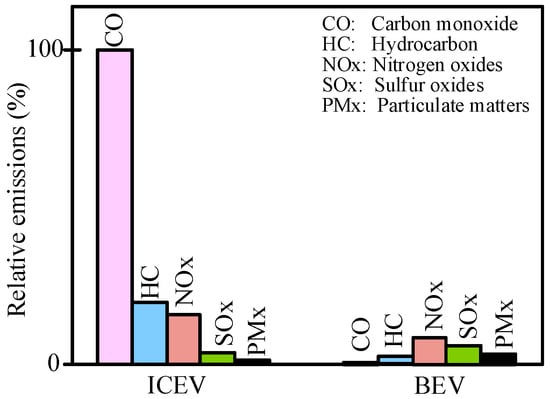
Figure 2.
Comparison of harmful emissions between BEVs and ICEVs.
The third impetus for the popularization of EVs is the business and economic opportunities for automotive industry. Global EV sales, mainly including BEVs and PHEVs, were about 14 million in 2023, bringing the total number of EVs on roads to around 40 million [], as depicted in Figure 3. The annual sales in 2023 were more than six times higher than those in 2018. It is anticipated that global EV sales can reach around 17 million in 2024, accounting for more than 20% of cars sold. It can be observed that the vast majority of EV sales and hence EVs on roads come from China, then Europe, and then the United States [,]. These trends indicate that the growth of EVs remains increasing and robust, while China remains the major EV player in terms of investment, manufacturing, and penetration.
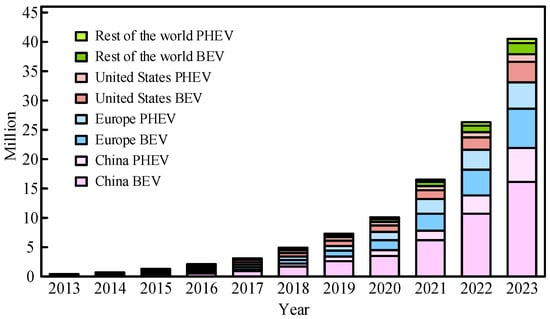
Figure 3.
Global EVs on roads.
Because of the above three impetuses, EV research has become one of the hottest research areas in recent decades. The first International Electric Vehicle Symposium and Exposition (EVS) was launched in 1969, which signified the beginning of active EV research. The EVS series, from the EVS-1 in Phoenix, USA in 1969 to the latest EVS-38 in Gothenburg, Sweden in 2025, are enabling EV researchers to keep abreast of the fast-changing development of EVs. However, EV education is significantly lagging behind EV research [,]. The EV courses and programmes are far from sufficient to train engineers and managers for the fast-growing EV community [,].
The purpose of this paper is to present a new graduate degree programme, Master of Science in Electric Vehicles (MScEV), for engineering students in Hong Kong Polytechnic University, which is timely and vital to train engineers, managers, and researchers for the fast-growing EV community in modern society. Firstly, a survey of the existing EV education will be conducted and analyzed. Secondly, the structure of the MScEV programme including the core and elective courses will be described. Thirdly, it will be devoted to elaborating the compulsory courses of the programme. Some findings of this programme will be evaluated. Finally, a conclusion will be drawn.
2. EV Education
The first generation of EV education probably resulted from the outcomes of EV research. For instance, the EVS-1 proceedings published in 1969 was earlier than most available EV books []. As a translation of EV research to EV education, a graduate degree course, “Electric Vehicles”, was developed by the Department of Electrical Engineering, Hong Kong Polytechnic University, as an elective course for Master of Science in Electrical Engineering in 1994. At that time, 30 years ago, the teaching material was mainly sourced from the EVS proceedings, plus a few reference books []. Then, an undergraduate degree course, “Electric Vehicle Technology”, was developed by the Department of Electrical and Electronic Engineering, University of Hong Kong, as an elective course for Bachelor of Engineering in Electrical and Electronic Engineering in 1996 []. As an extension from this course, a graduate degree course, “Advanced Electric Vehicle Technology”, was developed for Master of Science in Engineering in Electrical and Electronic Engineering at the University of Hong Kong in 1999.
Over the years, in response to the fast-growing EV community, various universities around the world have developed EV-related courses and programmes at both the undergraduate and graduate degree levels. For effective teaching and learning of EV technology, students should have undergraduate engineering knowledge and skills as a foundation. Thus, EV-related courses and programmes are preferably at the graduate degree level.
A survey was conducted on the general or comprehensive master’s degree programmes incorporating some EV-related courses. Since there are many universities and programmes involved around the world, relevant programmes with English as a medium of instruction offered by the top 100 universities within the QS World University Rankings 2025 are summarized in Table 1. It can be observed that there are eleven universities in Europe, six universities in Asia, and three universities in North America offering general master’s degree programmes with EV-related courses, which cannot reflect the distribution of global EVs on roads as shown in Figure 3. Particularly, there are only five universities in China including Mainland and Hong Kong with EV-related courses, which is far from enough to train engineers and managers for the EV industry and market in China.

Table 1.
General master’s degree programmes with EV-related courses.
Differing from offering one or two EV-related courses in the general master’s degree programmes, it is much more demanding and challenging to offer a specific master’s degree EV-related programme. Namely, it needs to be composed of various EV-related technologies including system design, operation, and management of EVs as well as specific EV topics. Thus, another survey was conducted on the specific master’s degree EV-related programmes around the world. Table 2 summarizes those programmes with English as a medium of instruction offered by the top 500 universities within the QS World University Rankings 2025. It can be observed that there are 11 universities in Europe and eight universities in Asia offering specific EV-related programmes. Among those universities in Asia, only one university in China offers a specific master’s degree EV-related programme, namely the newly developed MScEV in Hong Kong, China, which does not match with China being the major EV player in terms of investment, manufacturing, and penetration.

Table 2.
Specific master’s degree EV-related programmes.
Based on these two surveys, it illustrates that the EV education is significantly lagging behind the market and societal needs, and the EV courses and programmes are far from sufficient to train engineers and managers for the EV sector. It is highly desirable to develop more EV courses and programmes in response to the fast-growing penetration of EVs, especially in Asia and China.
3. Programme Structure
In response to the fast-growing EV market in the whole world, especially in China, Hong Kong Polytechnic University has launched the first master’s degree in EVs in Hong Kong, China, and the whole Southeast Asia. The aims of this MScEV programme are summarized as follows:
- To provide students with a comprehensive foundation in EVs, covering both research and practical applications.
- To meet the growing demand for high-quality professionals in the field of EVs, both in Hong Kong, China, and globally.
- To prepare students for future study and research in the field of EVs and to provide them with practical experience in how the industry is adapting to low carbon, and electric mobility solutions.
This MScEV programme is hosted by the Department of Electrical and Electronic Engineering, Hong Kong Polytechnic University. To be eligible for graduation, students need to successfully complete 30 credits. All courses carry three credits, except the optional nine-credit dissertation. Specifically, under the non-dissertation option, they need to complete 10 courses including two core courses and eight elective courses; or under the dissertation option, they need to complete seven courses including two core courses and five elective courses, plus a nine-credit dissertation. Meanwhile, students can engage in a full-time or part-time study load. In general, full-time students take two to three semesters and part-time students take four to five semesters for completion.
With the use of outcome-based teaching and learning, the MScEV programme has defined the following intended learning outcomes:
- Professional Competencies in EVs: Students will gain the ability to apply the knowledge and skills learned in this programme to design, develop, and optimize EVs and associated technologies thereby achieving a high level of professional competency in the field of EVs.
- Critical Thinking and Problem-Solving Abilities: Students will develop critical thinking skills in identifying and formulating problems related to EV development, as well as the ability to develop innovative methods for solving problems and making decisions in this field.
- Creativity and Innovation: Students will learn to appreciate and understand recent findings and advancements in EV technology and apply them effectively to solve problems and develop innovative solutions in this field.
- Capability for Continual Professional Development: Through inquiry and reflection on professional practice, students will develop the capability for continual professional development, enabling them to stay up-to-date with the latest developments and advancements in the field of EVs and to continue to enhance their skills and knowledge throughout their careers.
In order to achieve the intended learning outcomes, the curriculum was carefully devised. The key is to identify the themes of the curriculum to cater to the multidisciplinary nature of EVs. As depicted in Figure 4, the curriculum is composed of six themes.
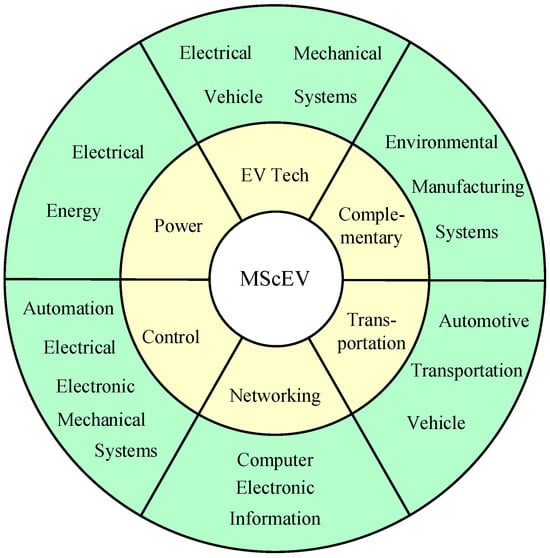
Figure 4.
MScEV curriculum structure.
- EV Tech: It covers the core technologies of EVs, such as the system design and integration, energy sources and storage, and electric and hybrid propulsion, as well as charging auxiliaries and standards [].
- Power: It focuses on power and energy technologies for EVs, such as electric motor drives, power electronics, mechanical, and electronic and magnetic transmissions, as well as bidirectional interaction between EVs and the power grid [].
- Control: It focuses on dedicated control theory and emerging control strategies for EVs, such as system control, optimal control, and autonomous control, as well as model-based engineering, artificial intelligence, and machine learning for EVs [].
- Networking: It focuses on networking and communication technologies for EVs, such as the vehicular networking between EVs and charging stations, as well as the Internet of Things (IoT) for remote monitoring and predictive maintenance between them [].
- Transportation: It covers various transportation systems for modern cities, such as the use of EVs for electrified transportation, the contribution of EVs for smart transportation, and the synergy between electrified and smart transportations for modern cities [].
- Complementary: It covers complementary knowledge and skills for EVs, such as policy and regulation, business models and finance, and market and industry trends, as well as project management, maintenance, and reliability for EVs [].
Because of the multidisciplinary nature of EVs, the admission requirement of this MScEV programme involves a bachelor’s degree in engineering or related disciplines, such as automation engineering, automotive engineering, computer engineering, electrical engineering, electronic engineering, energy engineering, environmental engineering, information engineering, manufacturing engineering, mechanical engineering, systems engineering, transportation engineering, or vehicle engineering. Undergraduate engineering knowledge and skills can facilitate them to adapt to at least one of the themes of the programme, as shown in Figure 4. For instance, the background in electrical and electronic engineering can facilitate students to learn well in EV technology, power, control, and networking themes, whereas a background in manufacturing and systems engineering can facilitate them to learn well in the EV technology and complementary themes.
For the whole curriculum, there are 16 courses in which 2 are cores and 14 are electives. The core courses are compulsory while the elective courses are optional for students to take and pass before graduation. Besides the nine-credit dissertation, the core and elective courses are three credits and categorized into the six themes. The dissertation can on any topic relating to EVs, which is in lieu of three other elective courses. Table 3 summarizes these 16 courses as well as their types, credits, and themes. It can be found that there are two to three courses offered under each of the six themes, which aims to cater to the students with different engineering backgrounds.

Table 3.
MScEV core and elective courses.
If students opt for the dissertation option, the topic of each dissertation is subject to mutual discussion between students and supervisors. It aims to train students in research methodology and conducting specific EV research topics hence preparing them for working in a research lab or pursuing a PhD degree after graduation.
4. Compulsory Courses
While providing students with the maximum flexibility to select various themes and elective courses as well as the full-time and part-time study loads, they have to successfully complete two compulsory courses before graduation. These two compulsory courses are the core courses of the curriculum, which were designed to accommodate different engineering backgrounds of the students and are considered essential to reflect the uniqueness of the MScEV programme.
The course, “Electric Vehicles”, is one of the two compulsory courses of the programme, covering a wide range of basic knowledge and skills for EVs. Table 4 summarizes the corresponding syllabus and allocated contact hours. It includes various technologies for EVs such as the system designs and configurations, vehicle dynamics and motor drives, batteries and battery management, and auxiliary indicators and units, as well as the introduction of EVs, their historical perspective, current development, and emerging technologies. Students completing this compulsory course indicate that they can meet the intended learning outcomes; particularly, they can gain the ability to apply their knowledge and skills to design EVs and associated technologies, and they can develop critical thinking skills in identifying and solving problems related to EV development. Leveraging the strong research capabilities in the field of EVs at the Department of Electrical and Electronic Engineering, Hong Kong Polytechnic University, this course aligns with the global trends in EV education, providing a comprehensive and up-to-date learning experience.

Table 4.
Syllabus of course “Electric Vehicles”.
The course, “Tomorrow’s Leader in Electric Vehicles”, is another compulsory course of the programme, which focuses on providing complementary knowledge and skills for EVs. Table 5 summarizes the corresponding syllabus and allocated contact hours. Differing from other courses, this course is based on a series of seminars to provide students with a comprehensive exploration of the technologies, societal impacts, policy, business, and project aspects of EVs. Apart from the course coordinator, most seminars are delivered by professionals, industrialists, and government officials in the EV community so that students can directly interact with speakers to gain practical knowledge and invaluable experience. They can also develop critical thinking, analytical, and communication skills. For example, in the academic year 2024/25, several senior executives and engineers from leading EV companies, including BYD, NIO, and Xiaomi Auto, are invited to share their expertise on EV product development as well as insights into future EV developments and engage in discussions with students about the evolution of the EV industry, enabling students to gain practical knowledge and real-world perspectives on the challenges and opportunities in the field. Given the significant influence of these companies in China and Southeast Asia, this course prepares students to effectively contribute to the rapidly growing EV sector in the region. By the end of this compulsory course, they not only meet the intended learning outcomes, but also learn to understand recent findings in EV technology to derive innovative solutions and develop the capability for continual professional development to stay up-to-date with the latest EV development throughout their careers.

Table 5.
Syllabus of course “Tomorrow’s Leader in Electric Vehicles”.
5. Evaluation
The MScEV programme was launched in October 2023 with the application deadline of April 2024 for the first intake of the academic year 2024/25. It has attracted an overwhelming number of applications, thanks in part to the successful information sessions held during the application period, which promoted awareness of the programme and addressed potential applicants’ questions and concerns. These applicants possess bachelor’s degrees in various engineering disciplines. Figure 5 depicts the distribution of their bachelor’s degrees covering electrical engineering, mechanical engineering, electronic engineering, automation engineering, vehicle engineering, computer engineering, information engineering, energy engineering, automotive engineering, transportation engineering, and others. It indicates that the applicants come from different engineering disciplines, though with higher percentages from electrical engineering (18.4%) and mechanical engineering (16.2%), who wish to enter the booming EV sector. Meanwhile, the corresponding working experiences are also categorized as depicted in Figure 5, which reveals that there is a very high percentage of fresh graduates (52.4%) applying for this programme. It is expected because there is no opportunity cost for them to select the MScEV while they anticipate that they will be highly competent in the EV sector after graduation.
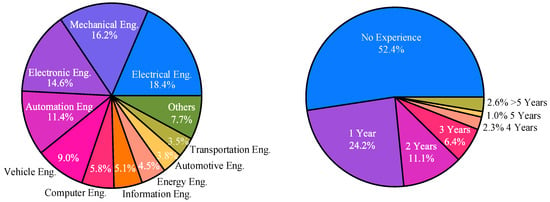
Figure 5.
Distributions of bachelor’s degree qualifications and working experiences of applicants.
Without specifically biassing any engineering discipline, the admission criteria are mainly based on academic qualification and working experience. For those borderline cases, online interviews are conducted, aiming to further clarify the ability and eagerness of the applicants to study the programme. To uphold the standard of this first master’s degree programme in EVs in the whole Southeast Asia, the admission process is highly competitive. The resulting distribution of bachelor’s degrees of the admittees is depicted in Figure 6. It shows that electrical engineering (21.5%) and mechanical engineering (18.7%) exhibit higher percentages, which agrees well with the corresponding distribution of applicants shown in Figure 5. On the other hand, the resulting distribution of working experiences of the admittees is also depicted in Figure 6. Although the percentage of fresh graduates (29.9%) among the admittees is still the majority, it is much lower than that among the applicants shown in Figure 5. It is due to the fact that working experience was counted as a merit in the admission process.

Figure 6.
Distributions of bachelor’s degree qualifications and working experiences of admittees.
6. Conclusions
A new graduate degree programme, MScEV, was developed in Hong Kong Polytechnic University for engineering students, which is timely and vital for modern society. Two surveys were conducted to illustrate that EV education is significantly lagging behind the needs of the technology, and EV courses and programmes are far from sufficient to train engineers and managers for the fast-growing penetration of EVs, especially in Asia and China. The purpose of this programme is to provide graduate students with up-to-date knowledge and skills that can significantly enhance their career prospects in the EV sector. The curriculum structure is carefully devised to include six themes, namely the EV technology, power, control, networking, transportation, and complementary, to cater to comprehensiveness, while offering flexibility for students to select various elective courses, taking the dissertation option or not, and adopting full-time or part-time study loads. The importance and uniqueness of the two compulsory courses are discussed and justified. Finally, the distributions of bachelor’s degree qualifications and working experiences of the applicants are compared to the corresponding distributions of the admittees, verifying that this graduate degree programme is attractive for students with different engineering backgrounds and working experiences. After the first batch of graduates, a comprehensive survey will be conducted to assess various metrics of the programme’s impact, including the satisfaction and employment outcomes of the students. Regular feedback will also be gathered from the graduates and employers about long-term career outcomes and graduates’ performance in the industry. The findings from the survey will be used to identify necessary improvements for the programme and will be reported in future updates.
Author Contributions
The authors made the following contributions: Conceptualization, K.T.C. and C.C.C.; Data Curation, K.T.C., S.N., W.L. and T.L.; Formal Analysis, K.T.C.; Investigation, K.T.C., C.C.C., S.N. and W.L.; Methodology, K.T.C. and C.C.C.; Project Administration, K.T.C. and C.C.C.; Resources, K.T.C., C.C.C., S.N. and W.L.; Supervision, K.T.C. and C.C.C.; Validation, K.T.C., S.N. and W.L.; Visualization, K.T.C. and T.L.; Writing—Original Draft, K.T.C.; Writing—Review and Editing, K.T.C., C.C.C., S.N., W.L. and T.L. All authors have read and agreed to the published version of the manuscript.
Funding
This work was supported by a grant from Hong Kong Polytechnic University, under Project No. P0048560.
Data Availability Statement
The original contributions presented in this study are included in the article. Further inquiries can be directed to the corresponding author.
Conflicts of Interest
The authors declare no potential conflicts of interest with respect to the research, authorship, and/or publication of this article.
References
- Wakefield, E.H. History of the Electric Automobile: Battery-Only Powered Cars; Society of Automotive Engineers: Warrendale, PA, USA, 1994. [Google Scholar]
- Alanazi, F. Electric Vehicles: Benefits, Challenges, and Potential Solutions for Widespread Adaptation. Appl. Sci. 2023, 13, 6016. [Google Scholar] [CrossRef]
- Chau, K.T. Energy Systems for Electric and Hybrid Vehicles; The IET: London, UK, 2016. [Google Scholar]
- Chan, C.C.; Chau, K.T. Modern Electric Vehicle Technology; Oxford University Press: Oxford, UK, 2001. [Google Scholar]
- Global EV Outlook 2024. Available online: https://www.iea.org/reports/global-ev-outlook-2024 (accessed on 1 July 2024).
- Razmjoo, A.; Ghazanfari, A.; Jahangiri, M.; Franklin, E.; Denai, M.; Marzband, M.; Astiaso Garcia, D.; Maheri, A. A Comprehensive Study on the Expansion of Electric Vehicles in Europe. Appl. Sci. 2022, 12, 11656. [Google Scholar] [CrossRef]
- Guzek, M.; Jackowski, J.; Jurecki, R.S.; Szumska, E.M.; Zdanowicz, P.; Żmuda, M. Electric Vehicles—An Overview of Current Issues—Part 2—Infrastructure and Road Safety. Energies 2024, 17, 495. [Google Scholar] [CrossRef]
- Yang, X.; Xiang, Y.; Lv, L.; Liu, J. Application of System Dynamics Approach in Scale Evolution of Electric Vehicles for Education. Int. J. Electr. Eng. Educ. 2021, 58, 306–318. [Google Scholar] [CrossRef]
- Kesler, S.; Boyaci, O.; Tumbek, M. Design and Implementation of a Regenerative Mode Electric Vehicle Test Platform for Engineering Education. Sustainability 2022, 14, 14316. [Google Scholar] [CrossRef]
- Saleet, H.; Aldamsah, A.; Banikhaled, M.; Abu-Baker, A.; Damseh, R.A.; Al-Smadi, M.; Mostafa, A.; Adaileh, W.; Alahmer, A.; Al-Salaymeh, A.; et al. Importance and Barriers of Establishing Educational/Training Programs in Electric Vehicles/Hybrid-Electric Vehicles in Jordan. World Electr. Veh. J. 2023, 14, 232. [Google Scholar] [CrossRef]
- Ravi, R.; Belkasmi, M.; Douadi, O.; Faqir, M.; Essadiqi, E.; Gargab, F.Z.; Ezhilchandran, M.; Kasinathan, P. Advancing Sustainable Transportation Education: A Comprehensive Analysis of Electric Vehicle Prototype Design and Fabrication. World Electr. Veh. J. 2024, 15, 354. [Google Scholar] [CrossRef]
- Shacket, S.R. The Complete Book of Electric Vehicles; Domus Books: Northbrook, IL, USA, 1979. [Google Scholar]
- Unnewehr, L.E.; Nasar, S.A. Electric Vehicle Technology; John Wiley & Sons: New York, NY, USA, 1982. [Google Scholar]
- Chau, K.T.; Chan, C.C. Electric Vehicle Technology—A Timely Course for Electrical Engineering Students. Int. J. Electr. Eng. Educ. 1998, 35, 212–220. [Google Scholar] [CrossRef]
- Ehsani, M.; Gao, Y.; Longo, S.; Ebrahimi, K. Modern Electric, Hybrid Electric, and Fuel Cell Vehicles, 3rd ed.; CRC Press: Boca Raton, FL, USA, 2018. [Google Scholar]
- Noel, L.; de Rubens, G.Z.; Kester, J.; Sovacool, B.K. Vehicle-to-Grid: A Sociotechnical Transition Beyond Electric Mobility; Springer Nature: Cham, Switzerland, 2019. [Google Scholar]
- Guvenc, L.; Aksun-Guvenc, B.; Zhu, S.; Gelbal, S.Y. Autonomous Road Vehicle Path Planning and Tracking Control; Wiley-IEEE Press: Hoboken, NJ, USA, 2022. [Google Scholar]
- Padmanaban, S.; Palanisamy, S.; Chenniappan, S.; Holm-Nielsen, J.B. Artificial Intelligence-based Smart Power Systems; Wiley-IEEE Press: Hoboken, NJ, USA, 2022. [Google Scholar]
- Nanaki, E.A. Electric Vehicles for Smart Cities: Trends, Challenges, and Opportunities; Elsevier: Amsterdam, The Netherlands, 2020. [Google Scholar]
- Beeton, D.; Meyer, G. Electric Vehicle Business Models: Global Perspectives; Springer: Berlin/Heidelberg, Germany, 2015. [Google Scholar]
Disclaimer/Publisher’s Note: The statements, opinions and data contained in all publications are solely those of the individual author(s) and contributor(s) and not of MDPI and/or the editor(s). MDPI and/or the editor(s) disclaim responsibility for any injury to people or property resulting from any ideas, methods, instructions or products referred to in the content. |
© 2025 by the authors. Published by MDPI on behalf of the World Electric Vehicle Association. Licensee MDPI, Basel, Switzerland. This article is an open access article distributed under the terms and conditions of the Creative Commons Attribution (CC BY) license (https://creativecommons.org/licenses/by/4.0/).